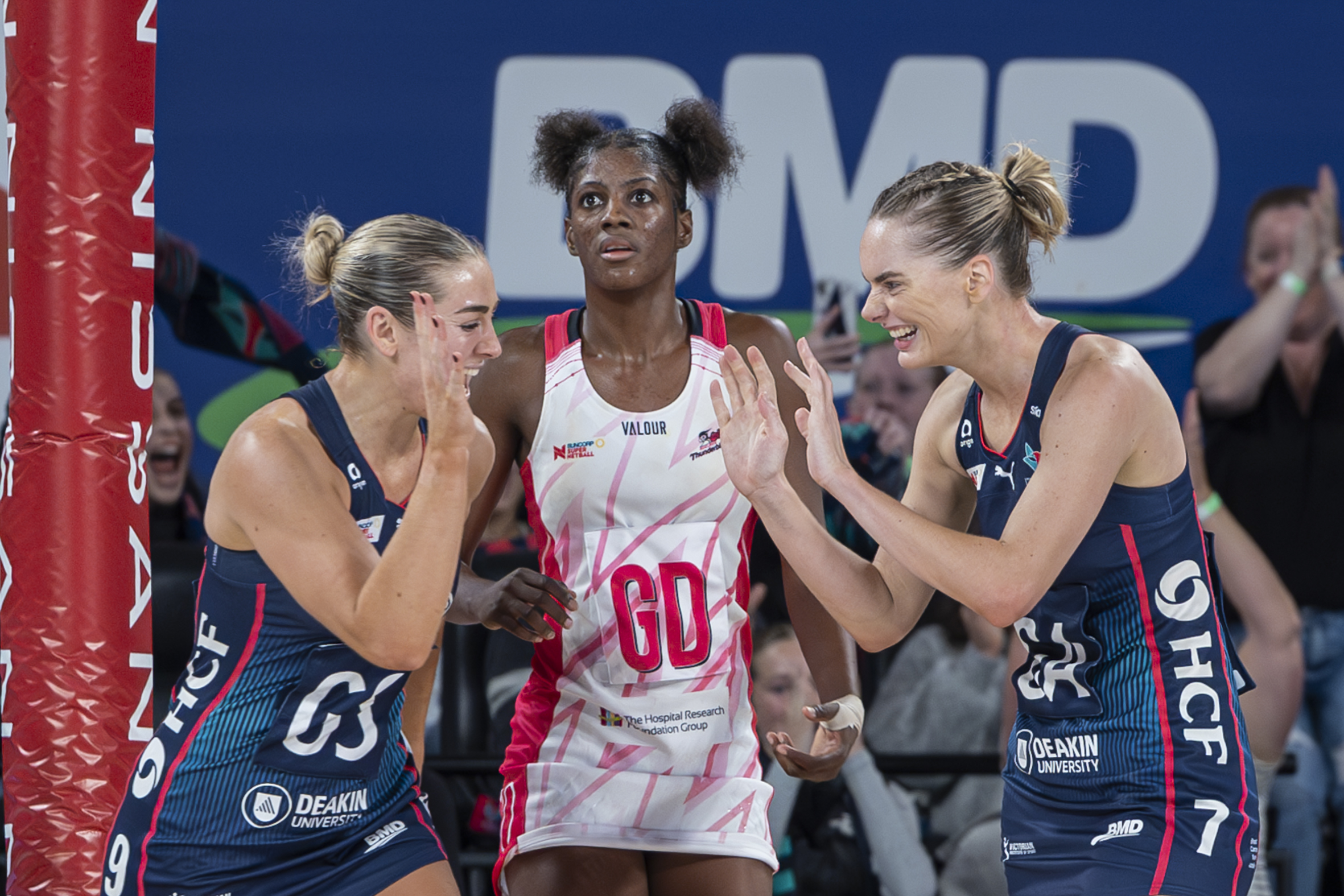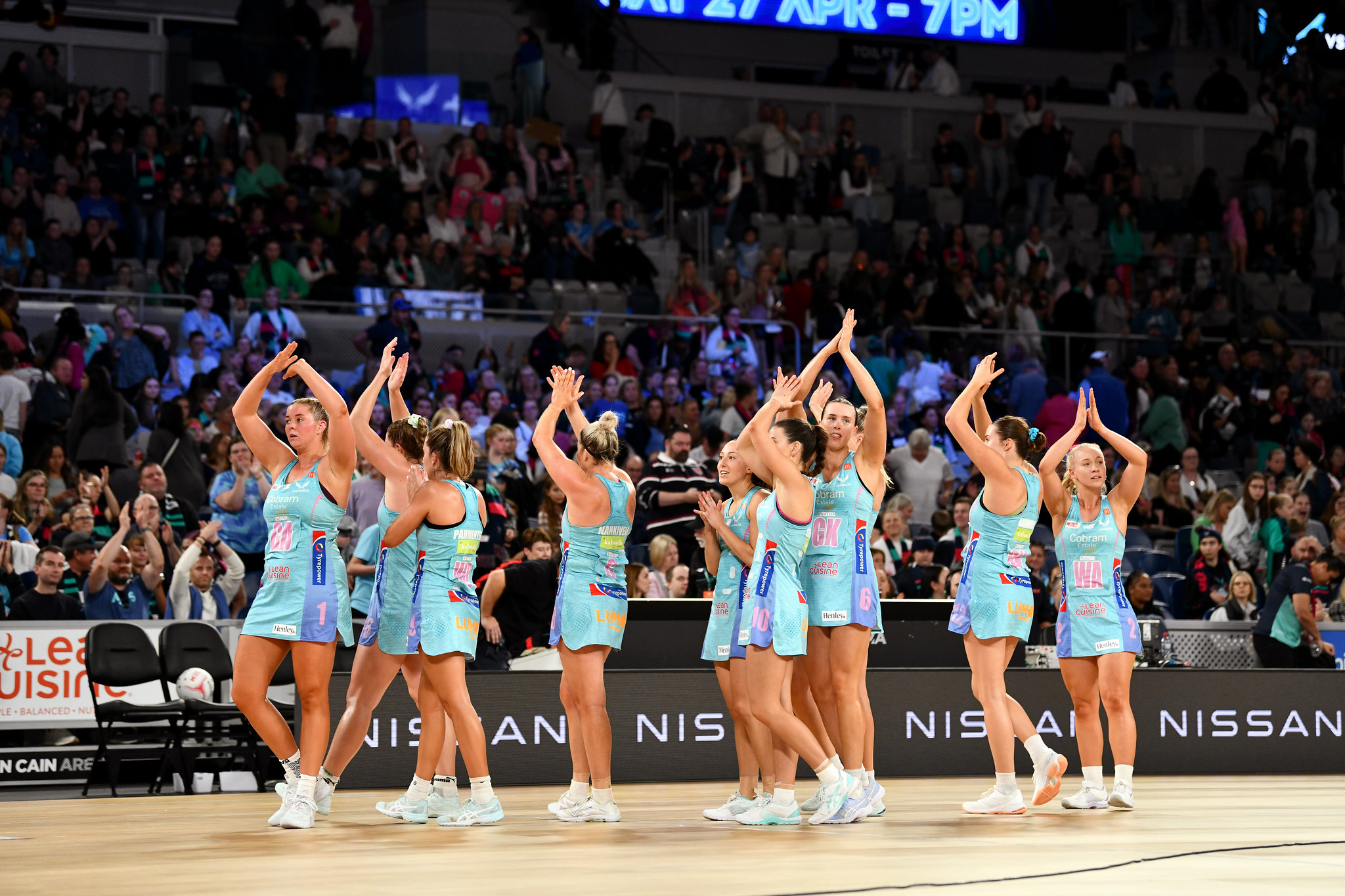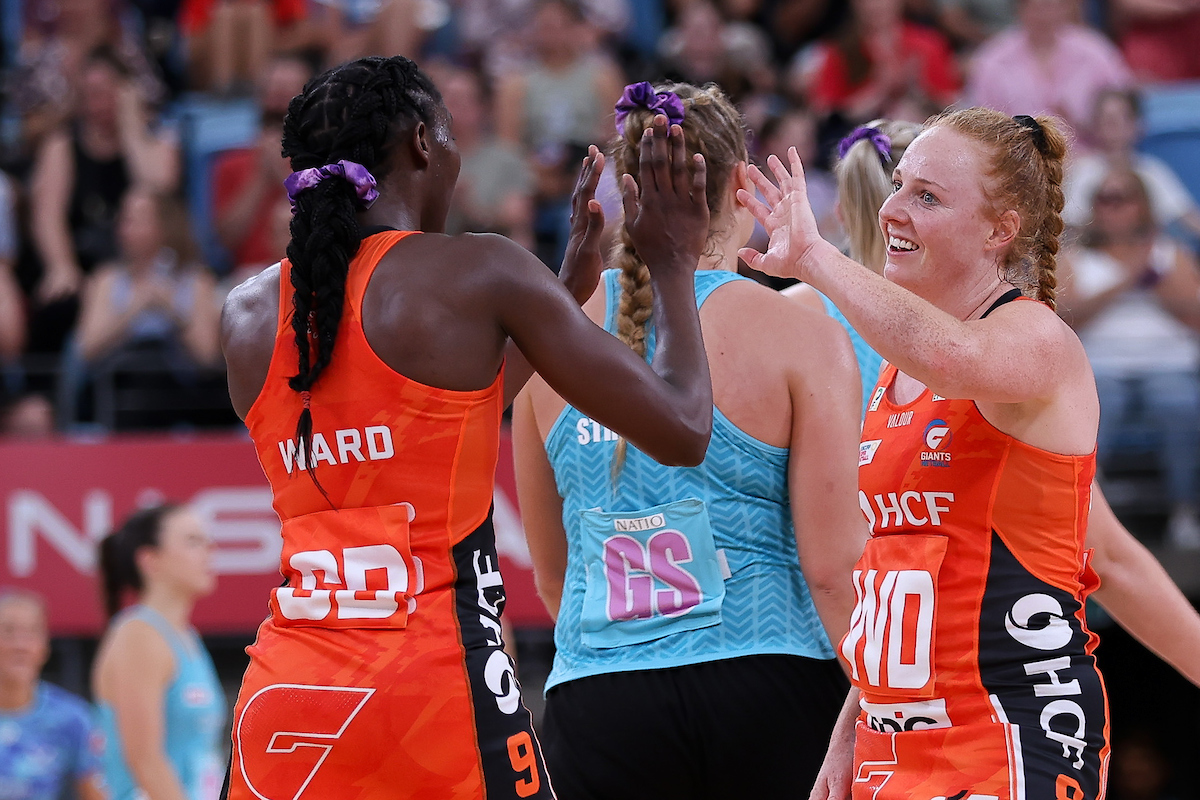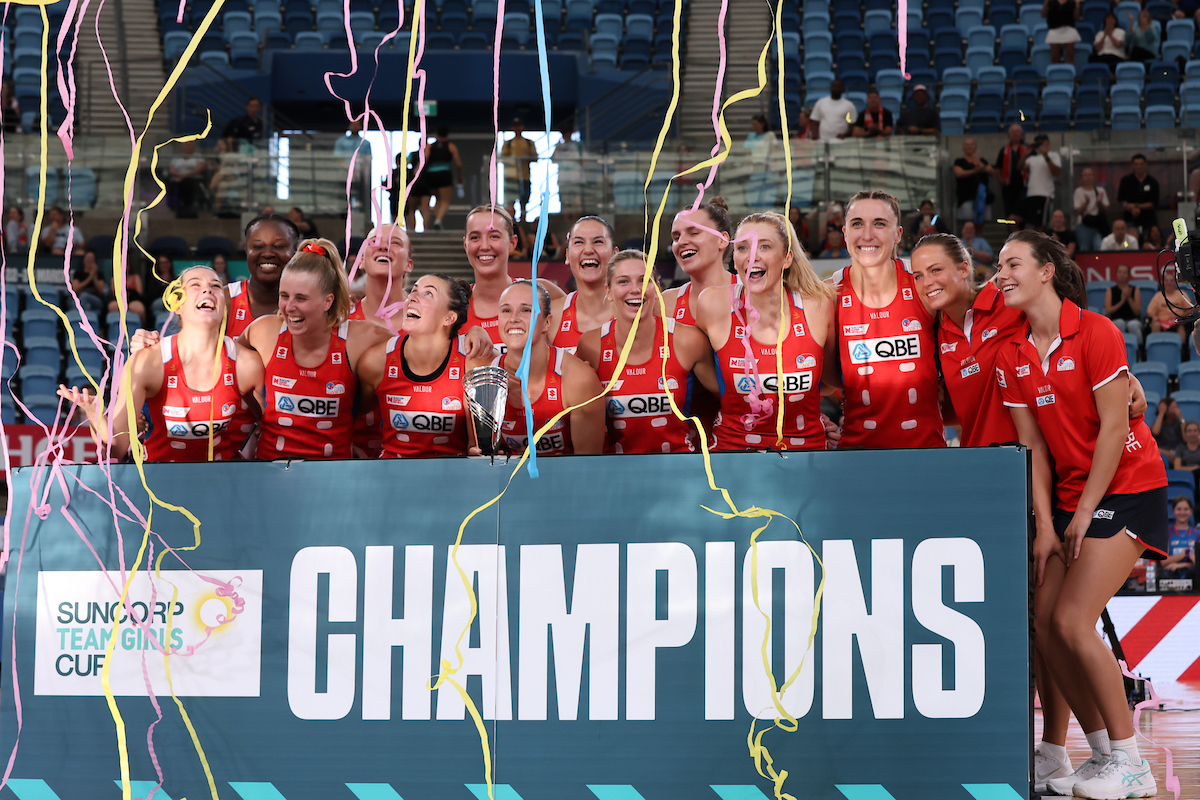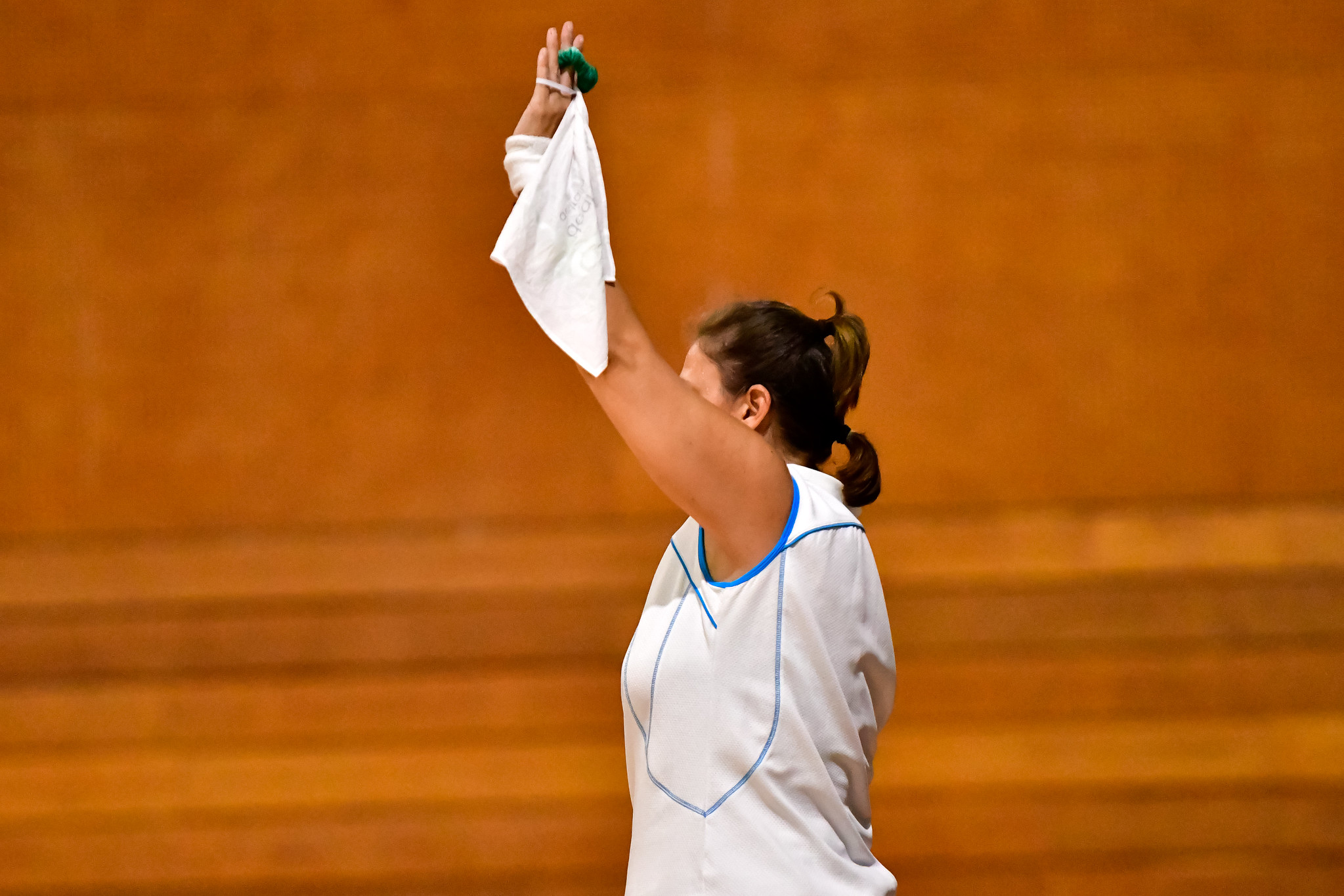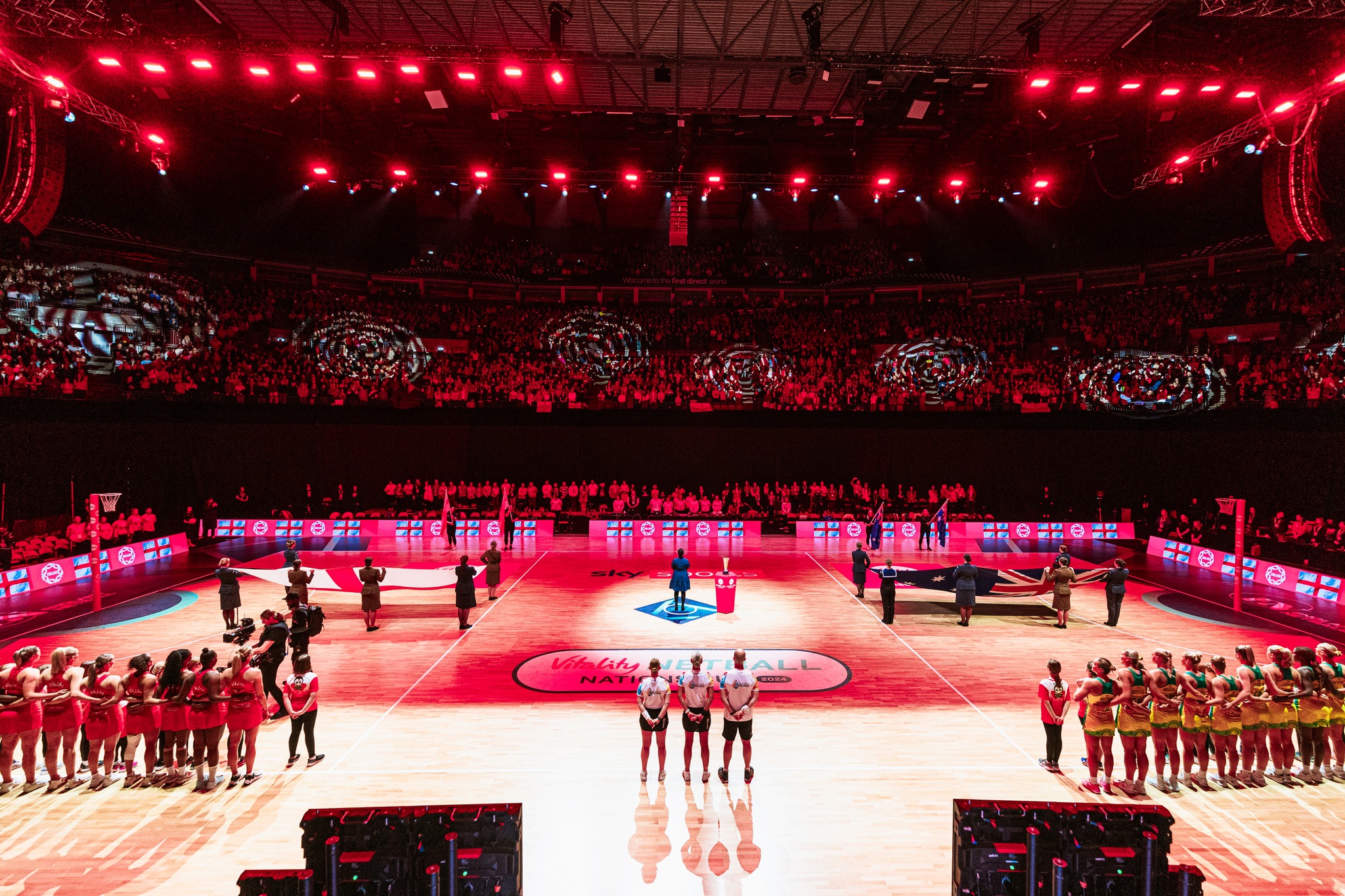Netball Scoop – Suncorp Super Netball – Round 10, 2020
RESULTS
Melbourne Vixens 63 drew with West Coast Fever 63 (14-16, 15-20, 16-15, 18-12)
Queensland Firebirds 77 defeated NSW Swifts 64 (19-12, 20-18, 19-18, 19-16)
Sunshine Coast Lightning 67 defeated GIANTS Netball 65 (18-18, 14-13, 17-17, 18-17)
Adelaide Thunderbirds 61 defeated Collingwood Magpies 49 (18-14, 15-15, 10-12, 18-8)
LADDER AFTER ROUND TEN
Position Points Percentage
1.Vixens . 34 . 116.2%
2.Swifts . 28 . 104.3%
3.Lightning . 28 . 100.5%
4.Fever . 22 . 105.3%
5.Thunderbirds . 16 . 97.3%
6.Giants . 14 . 97.6%
7.Firebirds . 14 . 93.1%
8.Magpies . 4 . 87.6%
INJURIES
It was the worst possible news for West Coast Fever’s Ingrid Colyer, with scans confirming that the wing attack had ruptured her ACL. Due to timing, she will not only miss the rest of the 2020 season, but there’s every chance she will miss most of 2021 too.
Em Mannix (Vixens) missed Round 10 with a calf strain, although she joked on the sidelines that really, she just didn’t want to play against Fever’s Jhaniele Fowler.
Kelsey Browne (ACL strain) and Madi Browne (retirement), both of Magpies, will miss the rest of the season.
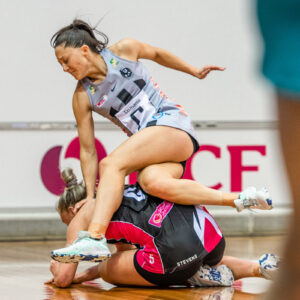
Molly Jovic and Hannah Petty were both concussed the last time they met, but somehow managed to stay out of trouble during their clash. Image Sue McKay
MILESTONES
Congratulations to South Australian midcourter Tyler Orr who made her Suncorp Super Netball debut for the Collingwood Magpies.
Allie Smith also made her debut for the Melbourne Vixens against Fever, playing wing defence in the second half and picking up two intercepts.
ROOKIE OF THE ROUND
It was the round of the rookies, with some exceptional talent on display.
In the first game of the round, Emma Cosh stepped into the injured Ingrid Colyer’s shoes at wing attack. After very limited court time in preceding rounds, Cosh had a strong game. Despite understandably tiring towards the end, she finished with 21 centre pass receives and 28 feeds.
In the second game, the steady hand of Lara Dunkley was a welcome addition to a Firebirds forward line that have been guilty of throwing away ball. Dunkley finished with 43 feeds and 17 centre pass receives.
But it was Tippah Dwan who was an absolute star for the Firebirds, smashing the previous Nissan Net Points record for goal attacks, with 142.5 points. Dwan had an extraordinary 37 center pass receives, 21 feeds, and 1 intercept, and shot 26/31 at 84% accuracy.
Maddie Hay (Giants) was a solid contributor with 33 feeds and 20 centre pass receives, while Mel Bragg (Magpies) took three intercepts to be one of her teams best performers.
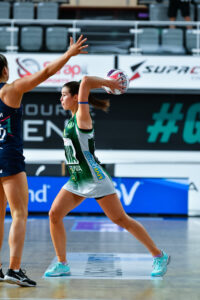
Emma Cosh relished her court time. Image: Simon Leonard
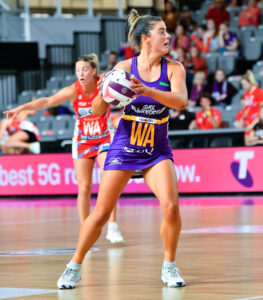
Lara Dunkley played a steady, consistent game at wing attack. Image Simon Leonard.
PLAYS OF THE ROUND
The ultimate in team play and core strength – Lenize Potgieter missed an easy shot in the first quarter that was rebounded by goal attack Georgie Horjus. At the same moment Chelsea Pitman was given a nudge into the circle.. Luckily, Horjus caught Pitman, gave her a cuddle, and pushed the dual citizen captain of Adelaide back out of the offside area. In the messy play, Thunderbirds eventually scored.
Once again, Kim Jenner was the recipient of the famous Helen Housby death stare. It’s always a physical contest between the two, and Housby seemingly doesn’t love the close attention that Jenner gives.
Cath Cox brought new terminology to netball when she described Helen Housby setting herself up as road kill. Housby was in the midcourt, when she was skittled by an opponent.
Alexia Mitchell spotted Channel 9 not attributing the use of a Simon Leonard photo of Madi Browne, and called it out. Photographers are some of the unsung contributors to sport, and it’s always disappointing when their efforts aren’t recognised.
So far this season the super shot hasn’t really impacted the final result of a game, but there was going to come a time when it happened. And so it proved in the Fever/Vixens game. The 63-63 draw would have been a good 62-54 goal win to the Fever without the supershot.
There have been increased mumblings and grumblings about the sight of Australian Diamonds captain and star goal shooter, firmly on sidelines for Giants’ matches. While the impact on the national team isn’t at the forefront of any franchises’ minds, given that the Giants aren’t putting many wins on the board it seems unusual that Bassett isn’t being given more of a run, particularly given her level head and calm hands. If there is one downside to Bassett’s game, it’s that she usually shoots from under the post, and the Giants are currently heavily relying on super shots to keep them in games. It would be interesting to see what the combination of Bassett and Kiera Austin could do, but it’s barely been sighted this season.
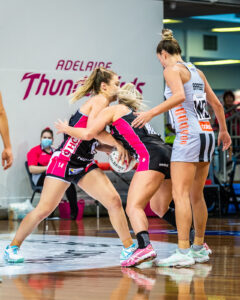
It was smart thinking by Georgie Horjus to shove her captain back onside with the ball. Image Sue McKay
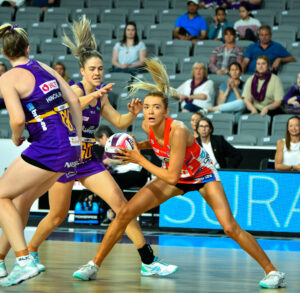
Not quite a death stare, but a look of total concentration from Helen Housby. Image Simon Leonard.
TEAM OF THE ROUND
Seventh placed Firebirds continued their improvement with a big take down of the second placed Swifts. Romelda Aiken continues to reinvent herself, but the game belonged to the young guns. Tippah Dwan led the way with an MVP performance, but the steady hands of Lara Dunkley and Mahalia Cassidy, and flashes of the brilliance from the back three all contributed to the win. The Swifts didn’t put out a poor performance, but were outmatched by a solid team performance.
An honourable mention also goes to West Coast Fever, who drew with ladder topping Melbourne Vixens. Fever had to insert a new player, Emma Cosh, into the wing attack role after losing Ingrid Colyer to an ACL injury, but despite the disruption held the wood on the Vixens for most of the game. Fever drew out to a 15 goal lead over the Vixens, who were missing Em Mannix, but tired in the last quarter as some sloppy turnovers and the Vixens’ supershot dominance saw them eke out a draw.
STATISTICALLY SPEAKING
Tippah Dwan had an outstanding game for the Firebirds. She finished the game on a simply incredible 142.5 Nissan Net Points shooting 26 goals from 31 attempts including eight supershots from nine attempts, 14 goal assists, an intercept, three deflections, two pickups, 37 centre pass receives and just three turnovers. Eight supershots in one game and such accuracy at that range is impressive enough, without considering the work involved in getting free for 37 centre pass receives, 9 more than any other player who took the court this weekend.

Gretel Bueta couldn’t be happier that her young protege surpassed her Nissan Net Points records. Image: Simon Leonard
2,400 minutes of netball have been played so far this season. Despite the tired legs, games are still being played at a frenetic pace. So, it’s no surprise that the penalty counts are rising. The exception is the Sunshine Coast Lightning. In Round 10 they only notched up 25 penalties. That’s 17 less than the next closest team. A low penalty count is not unheard of for Lightning. Most of the teams average well above 40 penalties a game, yet so far this season, Lightning have managed to keep their count below 40, four times including this Round 10 feat. The only other team to get below 40 was the Vixens in Round 9 when they got 35 penalties.
TALKING POINT OF THE ROUND
With the Diamonds squad set to be announced at the end of Round 14, conversations are starting to heat up about who might be included. Australia currently has limited depth in the goal shooter and goal attack position, and Caitlin Thwaites (international retirement) and Gretel Bueta (pregnancy) will be sorely missed in any games that might be held over the next six months. Several rookies will need to fill in the gaps, and punters are tipping Cara Koenen and possibly Tippah Dwan to be included in the squad.
There is a huge amount of depth in the midcourt and defensive ends, with numerous athletes putting their hand up for contention. The injury to Kelsey Browne potentially opens up a place for a mid-courter, while April Brandley’s recent pregnancy might also see a new defender introduced.
While it’s unknown at this point if the current selectors will hang on to their roles, or new selectors will be put in place, incoming Diamonds’ coach Stacey Marinkovich will undoubtedly have a strong opinion about the style of game that she wants to play, and the players who can best fit that need.
Given that the Diamonds have been without a coach for most of the year, while main rivals New Zealand and England squads and coaches have been in regular contact, there is an urgent need for the Diamonds to start the process of team bonding and setting off court behaviours. Some strong words in an article by Brian Roe, found here, would indicate that there is some work to be done.
TWEET OF THE WEEK

Lexi Mitchell is enjoying the form of Tippah Dwan

And calling it out when photographers aren’t acknowledged for their work.
STAND OUT STATISTICS
INDIVIDUAL
Goal Assists
Liz Watson (Vixens) – 25
Alice Teague-Neeld (Fever) – 23
Lara Dunkley (Firebirds) – 21
Gains
Phumza Maweni (Lightning) – 8 (1 intercept, 2 deflections with a gain, 5 rebounds)
Shamera Sterling (Thunderbirds) – 6 (3 intercepts, 3 rebounds)
Geva Mentor (Magpies) – 6 (1 intercept, 5 rebounds)
Supershots
Tippah Dwan (Firebirds) – 8/9
Jo Harten (GIANTS) – 7/8
Gabby Sinclair (Magpies) – 5/7
Kiera Austin (GIANTS) – 5/9
Mwai Kumwenda (Vixens) – 5/9
Centre pass receives
Tippah Dwan (Firebirds) – 37
Alice Teague-Neeld (Fever) – 28
Liz Watson (Vixens) – 28
Turnovers
Molly Jovic (Magpies) – 7
Emma Cosh (Fever) – 6
Liz Watson (Vixens) – 6
Tyler Orr (Magpies) – 6
Penalties
Kim Jenner (Firebirds) – 19
Courtney Bruce (Fever) – 16
Jodi Ann Ward (Magpies) – 16
Geva Mentor (Magpies) – 16
TEAM
Firebirds ( Nissan Net Points – 495, Goal Attempts – 69/85 81.2%, Feeds – 114, Gains – 13, Deflections – 19, Turnovers – 14, Penalties – 46)
Lightning (Nissan Net Points – 482.5, Goal Attempts 63/72 87.5%, 17 gains, 20 deflections, 24 possession changes, penalties – 25)

Chelsea Pitman on the move – one of those “caption this” moments. Image Sue McKay
Melbourne Vixens 63 drew with West Coast Fever 63
by Jane Edwards
WHO dominated?
This was a game of two halves: Fever soundly beat the ladder leaders in quarters 1 and 2 36-29, while Vixens won the second half 34 – 27. Consequently, neither team dominated for the whole match, resulting in the second draw of the season
With a stunning 59 goals from 62 attempts and five rebounds, Jhaniele Fowler dominated Fever’s scoring leaving Alice Teague-Neeld only four goals to score for the whole game. However, she wasn’t invincible. The Vixens gradually worked out how to limit the supply of good feeds to her, reducing her scoring from 18/18 in the second quarter to 12/12 in the fourth.
Meanwhile, Caitlin Thwaites continued her experience-driven transformation down the Vixens’ attack end, shooting one pointers and two pointers from GA or GS, to finish with 22/24 at 92%. Beyond her scoring contribution, she fed GS Mwai Kumwenda cleverly and had 11 centre pass receives, to be a worthy contender for player of the match. It would be worth cross-examining the selection panel about how she outpointed Fowler – she had a key turnover in the final minutes of the match when a held ball allowed the Fever to draw level.
WHAT worked?
After losing Ingrid Colyer last week with an ACL injury, Fever brought in debutante Emma Cosh for a full game at WA. She relished the challenge of playing against the experienced Vixens defence, and contributed 18 goal assists and 28 feeds to confident back up the leading Fever feeder Alice Teague-Neeld.
For both teams, it was the same defensive approach at different stages of the game. Fever’s first-half victory came from suffocating defence across the Vixens’ attacking transverse line, slowing the feeders’ leads to the circle edge and causing uncharacteristic confusion – Liz Watson had three held balls in the second quarter. It was strong run-with defence, and careful hands over the ball work by Jess Anstiss and Verity Charles that delivered the defensive turnovers.
When the Vixens needed to mount a comeback from 14 goals down in the third quarter, they tweaked their defensive lineup in a novel fashion. Jo Weston went back to GK, Kate Eddy to GD, and coming on at WD Allie Smith for her first match this season. In the absence of Emily Mannix, who was out with a calf injury, Vixens would be pleased that their defence stood up to the challenge.
WHAT needs improvement?
No amount of screaming at the screen from my house in locked-down Melbourne could convince the Vixens to play the ball around for longer before they took a one-goal lead with their final two-point shot at 14:45. Even another five seconds would have made the difference in preventing Fever from levelling the score. Few teams have had the presence of mind to adjust their play as the seconds tick down – to switch from a scoring strategy to a prevent-from-scoring strategy.
WHERE was it won?
Fowler’s reliability in the goal circle won Fever this draw. Even at one goal down with 15 seconds to go, Fever players are confident that all they need to do is get the ball to their GS to be certain of a score.
For the Vixens, it was the depth of their squad that enabled them to craft innovative combinations to break through Fever’s defence and undermine Fever’s one-dimensional path to goal in the third and fourth quarters. When the starting seven can’t work out, the seamless shooting substitutions will find a way; and the ability to move Jo Weston from WD to GK at will disrupted Fever’s attack sufficiently to win turnovers.
WHERE was it lost?
The two-point zone was not beneficent to Fever today, and revealed their scoring strategy to be too heavily reliant on supply of one-goal shots to Fowler. With only 3 scores from 8 attempts, GA Alice Teague-Neeld was relegated throughout the game to a third feeding role, but in fact she led centre pass receives, feeds and goal assists for the team. While she scored Fever’s only two pointer in the second quarter, it is a bit much to expect her to sink crucial shots to win the game when she has had so few other shooting opportunities to get her eye in. Three missed super shots that she missed in the fourth quarter could have made the difference for Fever.
WHEN was the game won and lost?
Halfway through the third quarter, Fever had a 14 goal lead, and could have cruised to victory with careful play. In the next seven minutes, Vixens outscored them 10-2, including four supershots.
Redemption came for Fever in the dying moments of the game. With 15 seconds to go, they brought the ball in three passes straight down the centre corridor, to Fowler who calmly slotted the shot that drew the scores.
HOW did she do that?!
In addition to her feeding duties, Alice Teague-Neeld was a valuable defensive disrupter, winning three gains in this match. One particularly skillful intercept came early in the third quarter when she channelled Kate Eddy to receive a pass in attack tight on the right sideline, put strong hands-over pressure on the ball, then nipped back to intercept the pass.
MVP Caitlin Thwaites (Vixens)
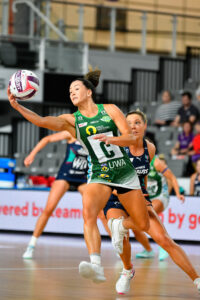
Verity Charles has been consistently good all season. Image Simon Leonard.

Sunday Aryang and Caitlin Thwaites compete in the air. Image Simon Leonard.
Queensland Firebirds 77 defeated NSW Swifts 64
By Ian Harkin
In a battle of second versus seventh, surprisingly it was the seventh placed Queensland Firebirds who controlled this match almost from the start. The Swifts challenged on occasions, but Firebirds had all the answers when it mattered and came away with a strong 13 goal win.
WHO dominated?
In what was just her tenth game at this level, 20-year-old Firebirds goal attack Tippah Dwan played like an old hand. At this early stage of her career, she shows a great temperament to go with her undoubted ability. Rebounding from what was a poor game the previous week, Dwan’s individual performance as well as her combination with Romelda Aiken proved too much for the Swifts defence. It sounds like such an obvious thing, but one facet of Dwan’s game is an ability to be almost always in just the right spot and to make just the right choice of whether to go to the post herself or set up Aiken instead.
The form of a rejuvenated Aiken is in some ways just as much of a revelation as Dwan. Hampered by a leg injury, Aiken was not a force in 2019. It was tempting to think her best days were well behind her, but far from it. This season, she is back to something approaching her very best form from the mid 2010s. In fact, Aiken’s movement has been a feature of the season. Having these two strong shooting options both firing is providing the Firebirds with a great attacking platform once again.
For Swifts, Sam Wallace was her usual reliable self. She scored the same number of goals as Aiken did, from less attempts, and was as rock solid as always. Wallace was a shining light for her team which otherwise found the going tough on the day. She and Helen Housby had a great battle in the circle with the strong Firebirds defensive combination of Tara Hinchliffe and Kim Jenner.
WHAT worked?
This was the second match between these teams in 2020. Swifts scored 64 goals in both clashes, but Firebirds’ score improved dramatically from 57 in round five to 77 in round ten, and that is a fair indication of the improvement of the team in attack. One of the big differences was the transition from defence. On numerous occasions, Swifts simply had no answer as the team in purple made their way down court at breathtaking speed.
Some may have been surprised at the decision of Firebirds’ coach Roselee Jencke to start Lara Dunkley at wing attack ahead of Jemma Mi Mi. Her performance showed it was a good call. Dunkley played with exactly the right balance between flair and steadiness, something that is sometimes lacking in Mi Mi’s game. With Dunkley and centre Mahalia Cassidy controlling play in the midcourt, Firebirds committed a total of just 14 turnovers for the match, nine less than in the round five match and well down on their season average.
WHAT needs improvement?
The Swifts’ all court defence was sadly lacking in this match. One of the hallmarks of the defending premiers’ game is their competitive defence, so often forcing opponents into error and not allowing an easy pass. That wasn’t the case in this game. A sign of the control that Firebirds had in attack was that Swifts were only able to make a total of four possession gains for the whole match, including just one solitary intercept. That is their lowest total for the season to date. In the defensive circle, Sarah Klau and Maddy Turner had just one gain each. On top of the Firebirds’ low number of turnovers, Swifts were left with precious little possession to mount a challenge. Given these circumstances, the Swifts’ midcourters, Maddy Proud, Nat Haythornthwaite and Paige Hadley did a good job of keeping their team in the contest for so long.
WHERE was it won?
Composure in attack and good decision making has not always been a trait of the Firebirds in recent years, but it was certainly on display in this game. Dwan, Dunkley and Cassidy combined for 53 assists and didn’t seem flustered at any point. The interchanges of passing in the Firebirds’ attack end was a highlight. The best option was almost always taken, and with Aiken providing such a solid target, the Swifts defence, try as they might, weren’t given much of a look in.
A measure of Firebirds’ consistency was their quarter by quarter scores; 19, 20, 19, 19. In the past, they have been guilty of losing concentration and fading out of matches, but in this match, they were running just as strongly and thinking just as quickly in the final 15 minutes of this game, as they were in the first 15.
WHERE was it lost?
The inability of Swifts to make an impression defensively, impacted on the whole team. Firebirds players were too often allowed to move down court, largely untroubled. As a result, they were able to score freely, putting scoreboard pressure on the champions who were forced to play catch up. They managed to do that on two occasions during the match, but not a third. As good as this Swifts team are in attack, even they eventually found the task too difficult.
WHEN was the game won and lost?
In 2020, Firebirds have been one of the best first quarter teams in the competition. The same can’t be said for their last quarter efforts so far. In some previous matches, they frittered away good starts with poor finishes. Not this time. Late in the third quarter was a pivotal moment in the game. Firebirds fans would have been getting extremely anxious, having seen their team’s lead whittled down to just one goal. That was when Firebirds put the foot down and went on an exhilarating 11-1 run, which effectively sucked the life out of Swifts’ challenge. With the score at 57-46 three minutes into the final period, the contest was as good as over.
HOW did she do that?!
Tippah Dwan will forever be associated with the super shot, having been the first player to sink one in a Suncorp Super Netball game. In the five weeks since, she has shown herself to be a top exponent of shooting from that distance. She does it calmly and without fuss. In this game, she was quite spectacular, landing eight of nine super shot attempts, and each one made life just that little bit harder for Swifts.
MVP: Tippah Dwan (Firebirds)
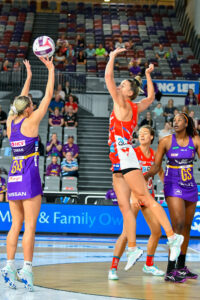
Tippah Dwan broke the Nissan Netpoints record for a GA, on the way to an MVP performance. Image Simon Leonard.
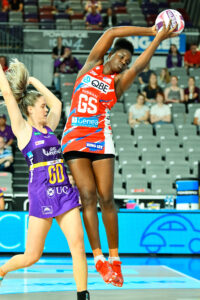
Sam Wallace was the Swifts best. Image Simon Leonard.
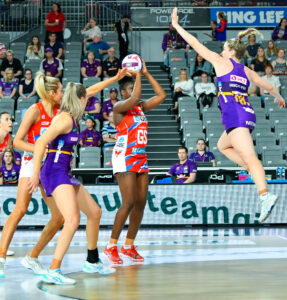
Tara Hinchliffe gets some serious air-time. Image: Simon Leonard
Sunshine Coast Lightning 67 defeated Giants Netball 65
By Andrew Kennedy
In one of the most closely contested matches of the season, the teams were nipping at each other for the whole hour. Even when Lightning established a seven-goal lead in the third quarter, it was reined in within a few minutes. Despite staying in contention, the Giants never established dominance, and had to catch up every quarter using super shots. It was all class and composure from Sunshine Coast, against a rising Giants lineup, closing out the game in the last 15 seconds with the perfect set play.
WHO dominated?
The defensive unit of the Queenslanders were decisive in the victory. Relative to Giants, they had more intercepts, deflections, rebounds, and fewer losses of possession in the back four. Karla Pretorius has been slightly off from her amazing standards in recent rounds, this week managing to lead all players with “only” five gains and three intercepts. Phumza Maweni also excelled in blocking space and vision to Jo Harten, restricting the English star to only 22 scoring shots, and grabbing an inspiring five rebounds. The two South Africans have seen almost no bench time but continue to serve up mind-boggling returns without fatigue.
WHAT worked?
Sunshine Coast were simply more consistent across the court. Their attack line is the best in the business at constant motion and reoffering, without the need to rush. Laura Langman once again demonstrated the variety of footwork that can be used in just 1.5 seconds with ball in hand, clearing the defence and opening a beautiful path to feed the post. Koenen also dodged at just the right time to open around two seconds, while Wood sliced into tiny spaces around the circle line and Scherian carved equally well through the middle and back into the pocket. This led to all three feeders balancing in the goal third and made the Giants defenders scramble throughout the match.
For the Sydneysiders, their 2-point accuracy is admirable. This match was near their best, 12/17 at 70%, enabling them to catch up at the end of each quarter, even if not truly threatening for the lead. In a very unusual outlying stat, Kiera Austin had six pickups at goal attack – her timing and commitment in defence was almost as good as her captain Harten at her best. Jamie-Lee Price utterly led the way in defence and attack for Giants, using her somehow simultaneously calm and aggressive manner to lead goal assists, take 2 intercepts and 4 gains, while giving away possession zero times. And Maddie Hay proved again to be extremely secure, not feeding with flair, but taking the option right in front of her and rarely giving away the ball.
WHAT needs improvement?
Giants struggled to function as a unit in attack, with their efforts one off. They couldn’t overcome the oppressive defence of Sunshine Coast, and were forced to make many extra passes in attack, leading to a lower shooting percentage. As Maddie Hay gets better integrated into the front line this should improve.
Conversely, when viewing Wood’s excellent long-range accuracy, she could be encouraged to more deliberately shoot the 2-point shots. Both Koenen and Proscovia are excellent rebounders, and in the last four rounds there is an opportunity to get in the rhythm of the super shot. Lightning continue to be slow starters, needing to find a formula to fire in the first quarter and decimate their opposition.
WHERE was it won?
A full team effort from Lightning, an experienced and cohesive line packed with composure. The special thing about the team is their ability to play structure and look out for each other, while also being able to pull out and dominate as an individual. They were able to dictate terms in the match, and the Giants couldn’t play their own brand of netball. Every Sunshine Coast player did their job, and did it calmly.
WHERE was it lost?
The lack of incisive play to the post in regular time for Giants is their downfall. Despite amazing shooting stocks, including the Australian captain Bassett on the bench, they only had 53 scoring shots in a match, compared to 63 for Lightning. This means they need 10 MORE 2-point shots than their opposition to even draw level and this tactic is risky at best. They have gradually addressed their heavy load of turnovers, but now need to come out onto the ball and get clean possession to truly threaten the top four.
WHEN was the game won and lost?
Giants threw on scoreboard pressure in the final five minutes with 4/4 supershots, leveling the score 65-all with 13 seconds to go, thanks to an amazing shoulder pass from Brandley. But it was a sensational connection from McAuliffe on the centre pass, to Wood, Scherian, then McAuliffe at circle edge, and Wood, resulting in a super shot that landed with 4 seconds to go, that finally gave the Queenslanders the win.
MVP: Phumza Maweni (Lightning)

Cara Koenen protecting the space and the ball. Image Simon Leonard.
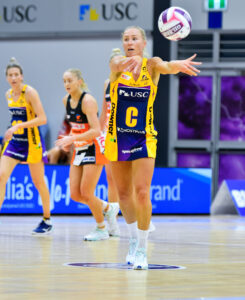
Laura Langman is a master of the look away pass. Image Simon Leonard.
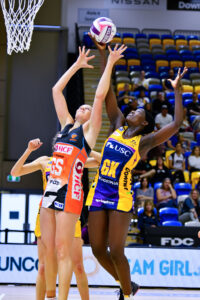
Phumza Maweni challenges for the ball in an MVP performance. Image Simon Leonard.
Adelaide Thunderbirds 61 defeated Collingwood Magpies 49
By Cara Gledhill
WHO dominated?
The Thunderbirds defensive duo of Shamera Sterling and Layla Guscoth were impressive. Sterling denied easy entry to Shimona Nelson in the circle and challenged her in the air taking six gains for the game and forcing Nelson into five turnovers before she was benched in the fourth. Guscoth played a strong marking game on Gabby Sinclair, particularly in the first quarter where Sinclair struggled to feed Nelson accurately.
Geva Mentor had another strong game on Lenize Potgieter. While Potgieter grew well throughout the game, Mentor was able to keep her relatively quiet across the first half, forcing Georgie Horjus to do a lot more work out the front to get the ball into shooting position.
Georgie Horjus was able to step up well for the home side. She shot accurately from all over the circle across the game and was a strong link on the feed into the circle. Horjus’ drive onto the ball against a fast-moving defender like Jodi-Ann Ward was impeccable.
WHAT worked?
The Magpies came out of halftime with a huge defensive focus and kept the Thunderbirds goalless for almost seven and a half minutes. Key to this was the full court defence from the Magpies who made it very difficult for the Thunderbirds to find a way through the mess. Mel Bragg had done her research on Chelsea Pitman, who was kept relatively quiet and wasn’t able to get into position for her usual drives onto the circle edge.
When the Thunderbirds made a change, moving Maisie Nankivell to wing attack in the final quarter, the Thunderbirds finally hit their stride in attack. Nankivell along with Tayla Williams in centre combined well with the two shooters. The relatively fresh-legged Williams put a struggling Magpies midcourt under pressure and the errors came thick and fast.
WHAT needs improvement?
The Magpies looked like they could win the game at times, but their inability to maintain the pressure for the whole 60 minutes was their downfall. They scored just eight goals in the final quarter against a Thunderbirds team that looked fitter, faster and more composed.
This is not surprising when you look at the outs for the Magpies this year and the amount of rookies (or near rookies) they have played this year. This pattern of falling away in the later part of games isn’t doing wonders for the Magpies’ percentage and has seen blowout scores in games that have seemed relatively close.
The Thunderbirds struggled at the beginning of the third quarter with plenty of errors coming into their game as the Magpies scored five unanswered goals against them. They were able to play through the moment and take the lead again, but a lapse of this nature with a team who scores more goals could be serious, so it will need to be addressed looking towards the final rounds.
WHERE was it won?
While the Thunderbirds didn’t look as dominant as they have in recent games, they hit their peak at the right point of the game. The changes in the midcourt worked for them and their attack end finally seemed to find some harmony, where it hadn’t quite looked on song for some of the game.
WHERE was it lost?
The Magpies lost their attack on the second phase ball in the last quarter and were less able to change up the defence that had served them so well in the first half. They turned over the ball ten times in the last quarter with the midcourt the primary culprits.
WHEN was the game won and lost?
It was anyone’s game at three quarter time. The fourth quarter was one of the best for the Thunderbirds and there’s no doubt that changes made by Tania Obst throughout the game helped when the going got tough in the final minutes. The Thunderbirds lifted a notch and the Magpies simply had no way of running with them.
HOW did she do that?!
Tyler Orr was announced as a member of the Magpies squad for the game this weekend. The young South Australian midcourter played 36 minutes for the Magpies and did not look overawed by the occasion, which is particularly impressive when you look at the limited training time she had with the team prior to taking the court.
MVP: Lenize Potgieter (Thunderbirds)
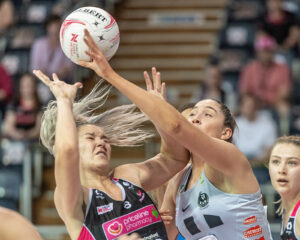
Lenize Potgeiter getting some close attention from the defenders. Image Sue McKay
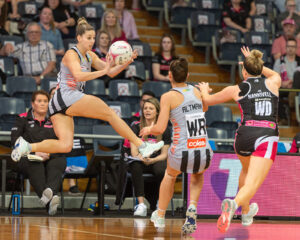
Mel Bragg on the drive through court. Image Sue McKay
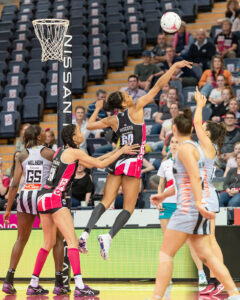
Shamera Sterling helps teammate Layla Gusgoth to fly high. Image Sue McKay
WHAT’S NEXT
Tuesday 8 September 5pm Swifts v Vixens USC Stadium Telstra TV / Netball Live
Tuesday 8 September 7.30pm Lightning v Fever USC Stadium Telstra TV / Netball Live
Wednesday 9 September 5pm Giants v Magpies USC Stadium Telstra TV / Netball Live
Wednesday 9 September 7.00pm Thunderbirds v Firebirds Priceline Stadium Telstra TV / Netball Live
NETBALL SCOOP PODCAST
Please tune into the Netball Scoop Podcast on Mondays and Thursdays throughout the 2020 Suncorp Super Netball Season. Co-hosts Alexia Mitchell and Phoebe Doyle cover the latest Suncorp Super Netball news, including post-match discussions and analysis, coach and player interviews, and have a special focus on the rookies of the competition. Just like the netball, the episodes are short and sharp – perfect for listeners on the go!


